ADNOC's Operational Improvements: Strategies, SWOT, and Porter's Five
VerifiedAdded on 2023/04/20
|23
|5892
|256
Report
AI Summary
This report provides a comprehensive analysis of Abu Dhabi National Oil Company (ADNOC) and its operational improvements. It begins with an overview of the company, highlighting its position as a major player in the oil and gas industry. The report then utilizes Porter's Five Forces framework to identify key competitive pressures, followed by a SWOT analysis to assess ADNOC's internal strengths and weaknesses, as well as external opportunities and threats. Furthermore, the report elaborates on ADNOC's resources and capabilities, outlining its operational strategies and providing recommendations for effective implementation, including fostering a learning culture within the organization. The document concludes with a list of references and an appendix.
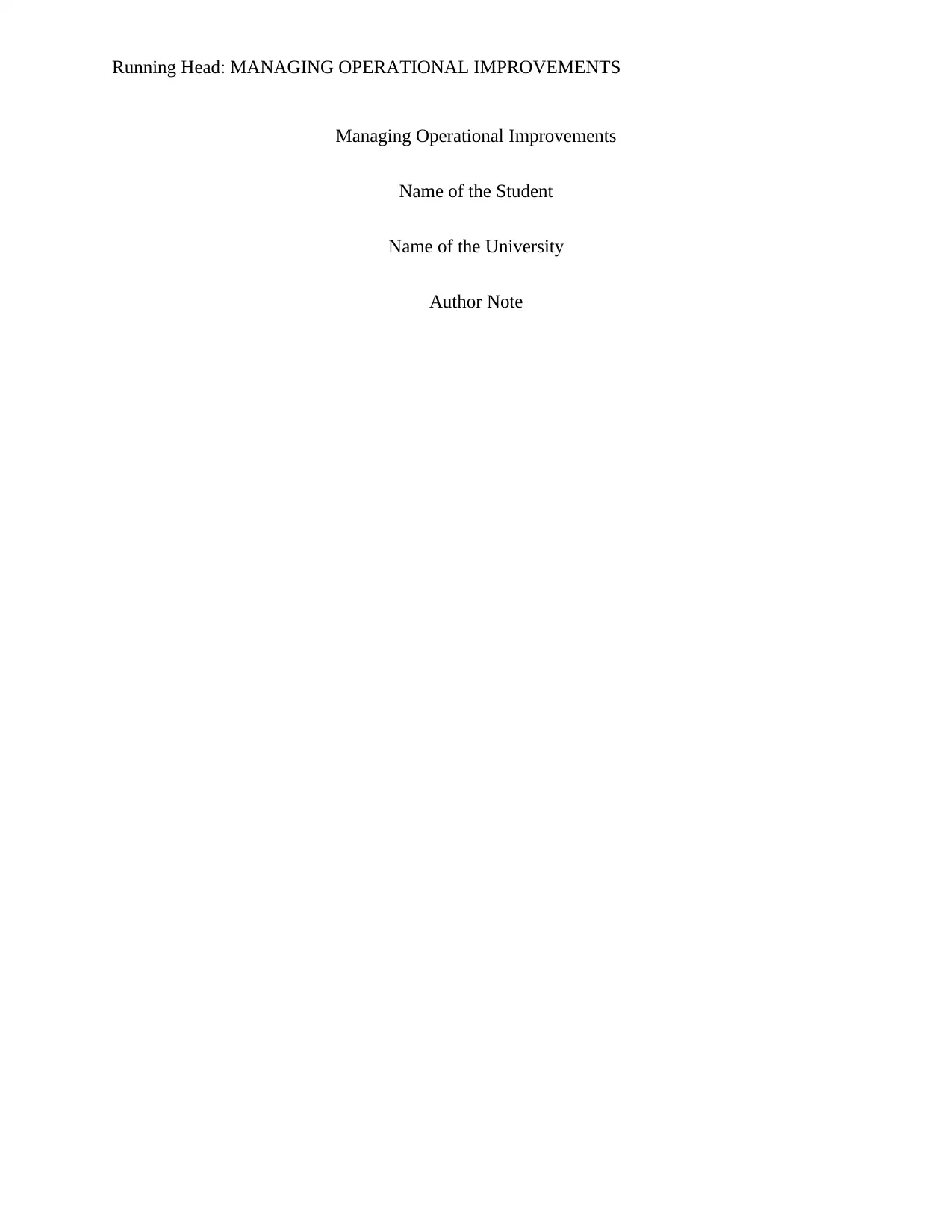
Running Head: MANAGING OPERATIONAL IMPROVEMENTS
Managing Operational Improvements
Name of the Student
Name of the University
Author Note
Managing Operational Improvements
Name of the Student
Name of the University
Author Note
Paraphrase This Document
Need a fresh take? Get an instant paraphrase of this document with our AI Paraphraser
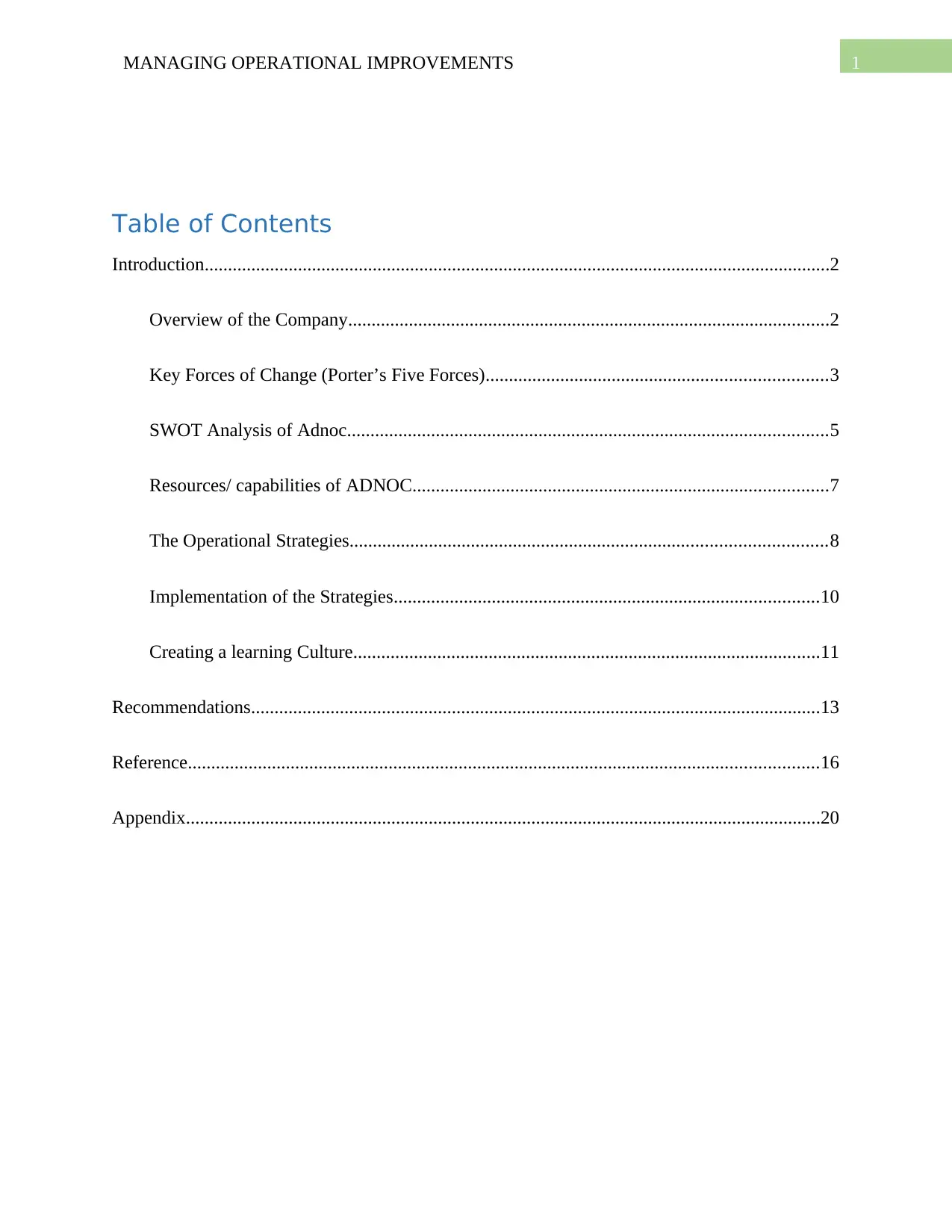
1MANAGING OPERATIONAL IMPROVEMENTS
Table of Contents
Introduction......................................................................................................................................2
Overview of the Company.......................................................................................................2
Key Forces of Change (Porter’s Five Forces).........................................................................3
SWOT Analysis of Adnoc.......................................................................................................5
Resources/ capabilities of ADNOC.........................................................................................7
The Operational Strategies......................................................................................................8
Implementation of the Strategies...........................................................................................10
Creating a learning Culture....................................................................................................11
Recommendations..........................................................................................................................13
Reference.......................................................................................................................................16
Appendix........................................................................................................................................20
Table of Contents
Introduction......................................................................................................................................2
Overview of the Company.......................................................................................................2
Key Forces of Change (Porter’s Five Forces).........................................................................3
SWOT Analysis of Adnoc.......................................................................................................5
Resources/ capabilities of ADNOC.........................................................................................7
The Operational Strategies......................................................................................................8
Implementation of the Strategies...........................................................................................10
Creating a learning Culture....................................................................................................11
Recommendations..........................................................................................................................13
Reference.......................................................................................................................................16
Appendix........................................................................................................................................20
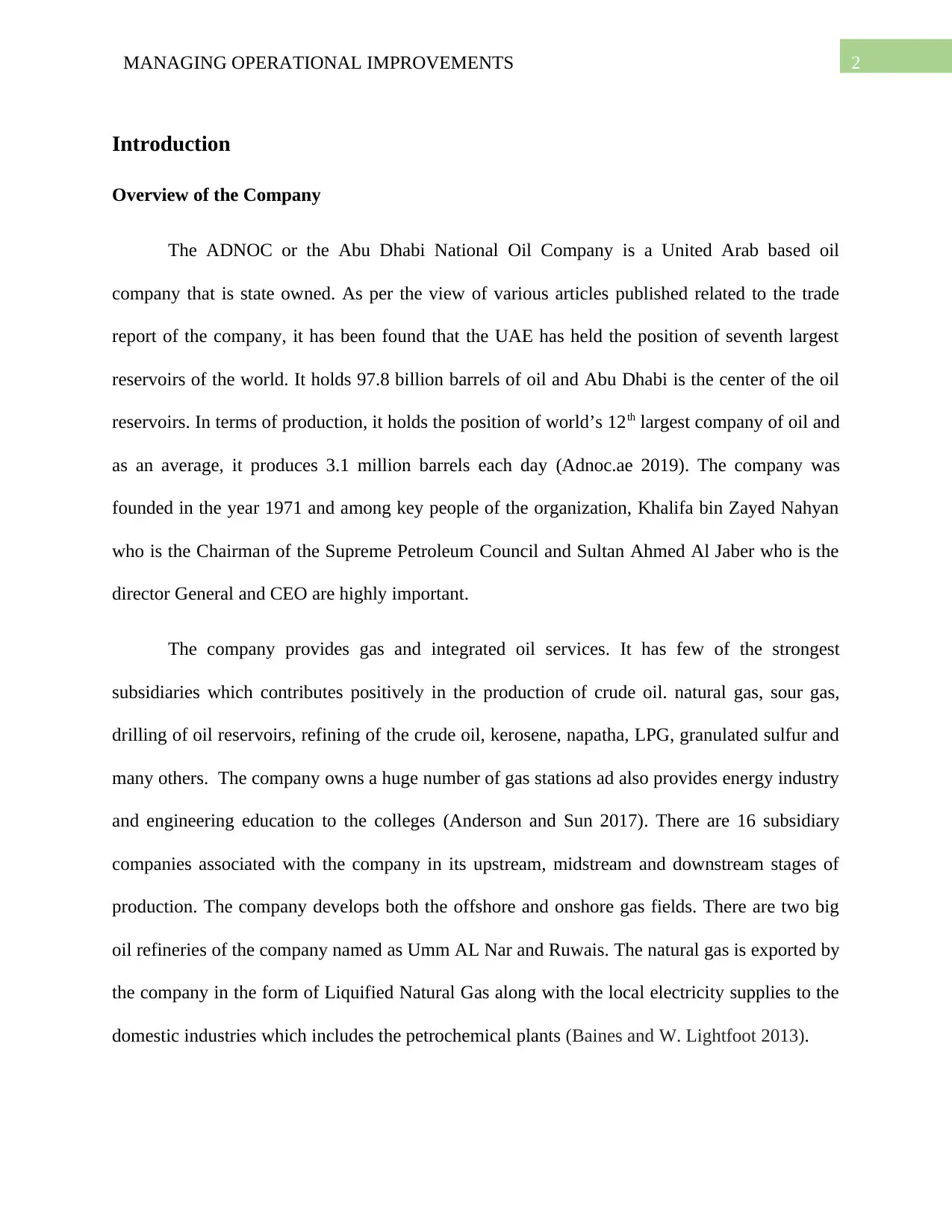
2MANAGING OPERATIONAL IMPROVEMENTS
Introduction
Overview of the Company
The ADNOC or the Abu Dhabi National Oil Company is a United Arab based oil
company that is state owned. As per the view of various articles published related to the trade
report of the company, it has been found that the UAE has held the position of seventh largest
reservoirs of the world. It holds 97.8 billion barrels of oil and Abu Dhabi is the center of the oil
reservoirs. In terms of production, it holds the position of world’s 12th largest company of oil and
as an average, it produces 3.1 million barrels each day (Adnoc.ae 2019). The company was
founded in the year 1971 and among key people of the organization, Khalifa bin Zayed Nahyan
who is the Chairman of the Supreme Petroleum Council and Sultan Ahmed Al Jaber who is the
director General and CEO are highly important.
The company provides gas and integrated oil services. It has few of the strongest
subsidiaries which contributes positively in the production of crude oil. natural gas, sour gas,
drilling of oil reservoirs, refining of the crude oil, kerosene, napatha, LPG, granulated sulfur and
many others. The company owns a huge number of gas stations ad also provides energy industry
and engineering education to the colleges (Anderson and Sun 2017). There are 16 subsidiary
companies associated with the company in its upstream, midstream and downstream stages of
production. The company develops both the offshore and onshore gas fields. There are two big
oil refineries of the company named as Umm AL Nar and Ruwais. The natural gas is exported by
the company in the form of Liquified Natural Gas along with the local electricity supplies to the
domestic industries which includes the petrochemical plants (Baines and W. Lightfoot 2013).
Introduction
Overview of the Company
The ADNOC or the Abu Dhabi National Oil Company is a United Arab based oil
company that is state owned. As per the view of various articles published related to the trade
report of the company, it has been found that the UAE has held the position of seventh largest
reservoirs of the world. It holds 97.8 billion barrels of oil and Abu Dhabi is the center of the oil
reservoirs. In terms of production, it holds the position of world’s 12th largest company of oil and
as an average, it produces 3.1 million barrels each day (Adnoc.ae 2019). The company was
founded in the year 1971 and among key people of the organization, Khalifa bin Zayed Nahyan
who is the Chairman of the Supreme Petroleum Council and Sultan Ahmed Al Jaber who is the
director General and CEO are highly important.
The company provides gas and integrated oil services. It has few of the strongest
subsidiaries which contributes positively in the production of crude oil. natural gas, sour gas,
drilling of oil reservoirs, refining of the crude oil, kerosene, napatha, LPG, granulated sulfur and
many others. The company owns a huge number of gas stations ad also provides energy industry
and engineering education to the colleges (Anderson and Sun 2017). There are 16 subsidiary
companies associated with the company in its upstream, midstream and downstream stages of
production. The company develops both the offshore and onshore gas fields. There are two big
oil refineries of the company named as Umm AL Nar and Ruwais. The natural gas is exported by
the company in the form of Liquified Natural Gas along with the local electricity supplies to the
domestic industries which includes the petrochemical plants (Baines and W. Lightfoot 2013).
⊘ This is a preview!⊘
Do you want full access?
Subscribe today to unlock all pages.

Trusted by 1+ million students worldwide
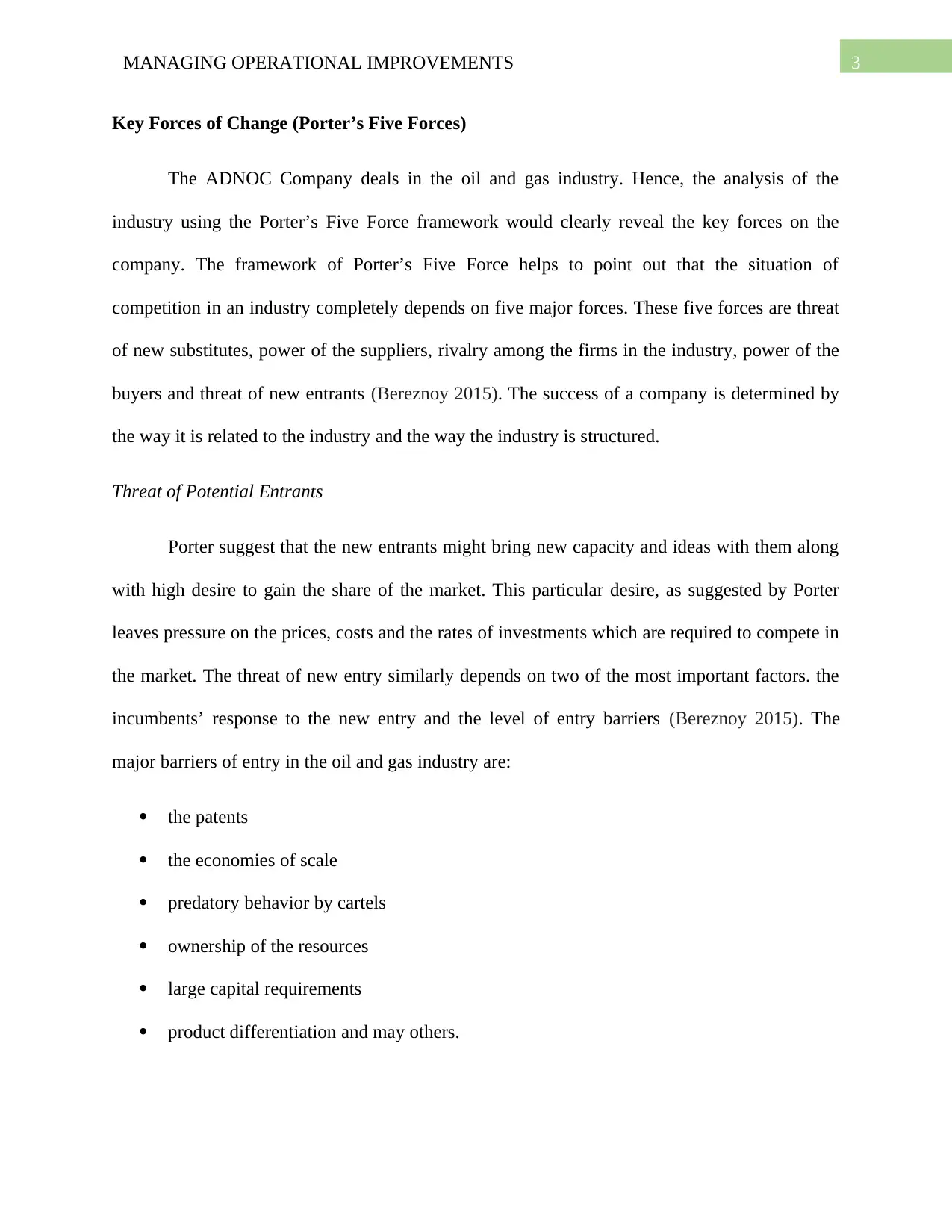
3MANAGING OPERATIONAL IMPROVEMENTS
Key Forces of Change (Porter’s Five Forces)
The ADNOC Company deals in the oil and gas industry. Hence, the analysis of the
industry using the Porter’s Five Force framework would clearly reveal the key forces on the
company. The framework of Porter’s Five Force helps to point out that the situation of
competition in an industry completely depends on five major forces. These five forces are threat
of new substitutes, power of the suppliers, rivalry among the firms in the industry, power of the
buyers and threat of new entrants (Bereznoy 2015). The success of a company is determined by
the way it is related to the industry and the way the industry is structured.
Threat of Potential Entrants
Porter suggest that the new entrants might bring new capacity and ideas with them along
with high desire to gain the share of the market. This particular desire, as suggested by Porter
leaves pressure on the prices, costs and the rates of investments which are required to compete in
the market. The threat of new entry similarly depends on two of the most important factors. the
incumbents’ response to the new entry and the level of entry barriers (Bereznoy 2015). The
major barriers of entry in the oil and gas industry are:
the patents
the economies of scale
predatory behavior by cartels
ownership of the resources
large capital requirements
product differentiation and may others.
Key Forces of Change (Porter’s Five Forces)
The ADNOC Company deals in the oil and gas industry. Hence, the analysis of the
industry using the Porter’s Five Force framework would clearly reveal the key forces on the
company. The framework of Porter’s Five Force helps to point out that the situation of
competition in an industry completely depends on five major forces. These five forces are threat
of new substitutes, power of the suppliers, rivalry among the firms in the industry, power of the
buyers and threat of new entrants (Bereznoy 2015). The success of a company is determined by
the way it is related to the industry and the way the industry is structured.
Threat of Potential Entrants
Porter suggest that the new entrants might bring new capacity and ideas with them along
with high desire to gain the share of the market. This particular desire, as suggested by Porter
leaves pressure on the prices, costs and the rates of investments which are required to compete in
the market. The threat of new entry similarly depends on two of the most important factors. the
incumbents’ response to the new entry and the level of entry barriers (Bereznoy 2015). The
major barriers of entry in the oil and gas industry are:
the patents
the economies of scale
predatory behavior by cartels
ownership of the resources
large capital requirements
product differentiation and may others.
Paraphrase This Document
Need a fresh take? Get an instant paraphrase of this document with our AI Paraphraser
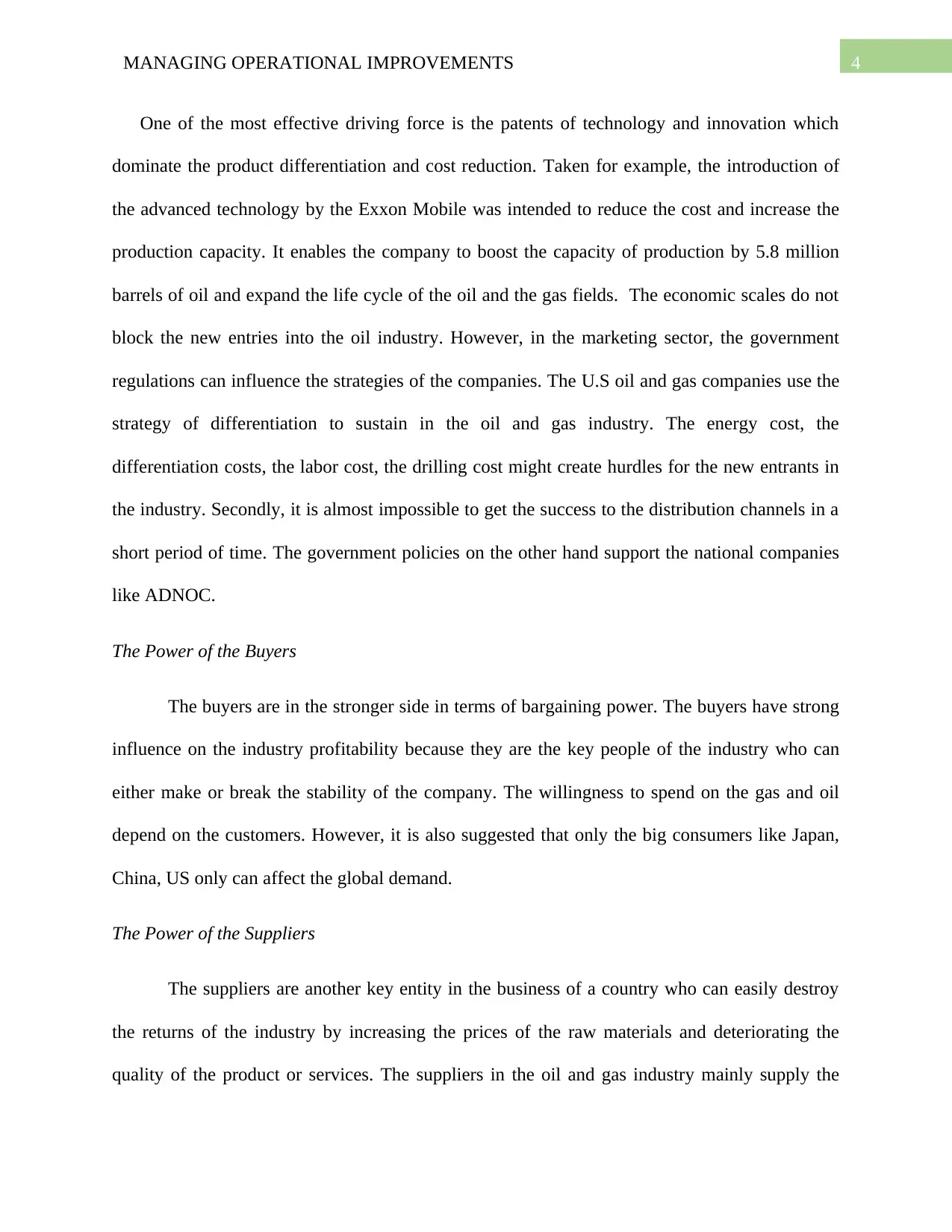
4MANAGING OPERATIONAL IMPROVEMENTS
One of the most effective driving force is the patents of technology and innovation which
dominate the product differentiation and cost reduction. Taken for example, the introduction of
the advanced technology by the Exxon Mobile was intended to reduce the cost and increase the
production capacity. It enables the company to boost the capacity of production by 5.8 million
barrels of oil and expand the life cycle of the oil and the gas fields. The economic scales do not
block the new entries into the oil industry. However, in the marketing sector, the government
regulations can influence the strategies of the companies. The U.S oil and gas companies use the
strategy of differentiation to sustain in the oil and gas industry. The energy cost, the
differentiation costs, the labor cost, the drilling cost might create hurdles for the new entrants in
the industry. Secondly, it is almost impossible to get the success to the distribution channels in a
short period of time. The government policies on the other hand support the national companies
like ADNOC.
The Power of the Buyers
The buyers are in the stronger side in terms of bargaining power. The buyers have strong
influence on the industry profitability because they are the key people of the industry who can
either make or break the stability of the company. The willingness to spend on the gas and oil
depend on the customers. However, it is also suggested that only the big consumers like Japan,
China, US only can affect the global demand.
The Power of the Suppliers
The suppliers are another key entity in the business of a country who can easily destroy
the returns of the industry by increasing the prices of the raw materials and deteriorating the
quality of the product or services. The suppliers in the oil and gas industry mainly supply the
One of the most effective driving force is the patents of technology and innovation which
dominate the product differentiation and cost reduction. Taken for example, the introduction of
the advanced technology by the Exxon Mobile was intended to reduce the cost and increase the
production capacity. It enables the company to boost the capacity of production by 5.8 million
barrels of oil and expand the life cycle of the oil and the gas fields. The economic scales do not
block the new entries into the oil industry. However, in the marketing sector, the government
regulations can influence the strategies of the companies. The U.S oil and gas companies use the
strategy of differentiation to sustain in the oil and gas industry. The energy cost, the
differentiation costs, the labor cost, the drilling cost might create hurdles for the new entrants in
the industry. Secondly, it is almost impossible to get the success to the distribution channels in a
short period of time. The government policies on the other hand support the national companies
like ADNOC.
The Power of the Buyers
The buyers are in the stronger side in terms of bargaining power. The buyers have strong
influence on the industry profitability because they are the key people of the industry who can
either make or break the stability of the company. The willingness to spend on the gas and oil
depend on the customers. However, it is also suggested that only the big consumers like Japan,
China, US only can affect the global demand.
The Power of the Suppliers
The suppliers are another key entity in the business of a country who can easily destroy
the returns of the industry by increasing the prices of the raw materials and deteriorating the
quality of the product or services. The suppliers in the oil and gas industry mainly supply the
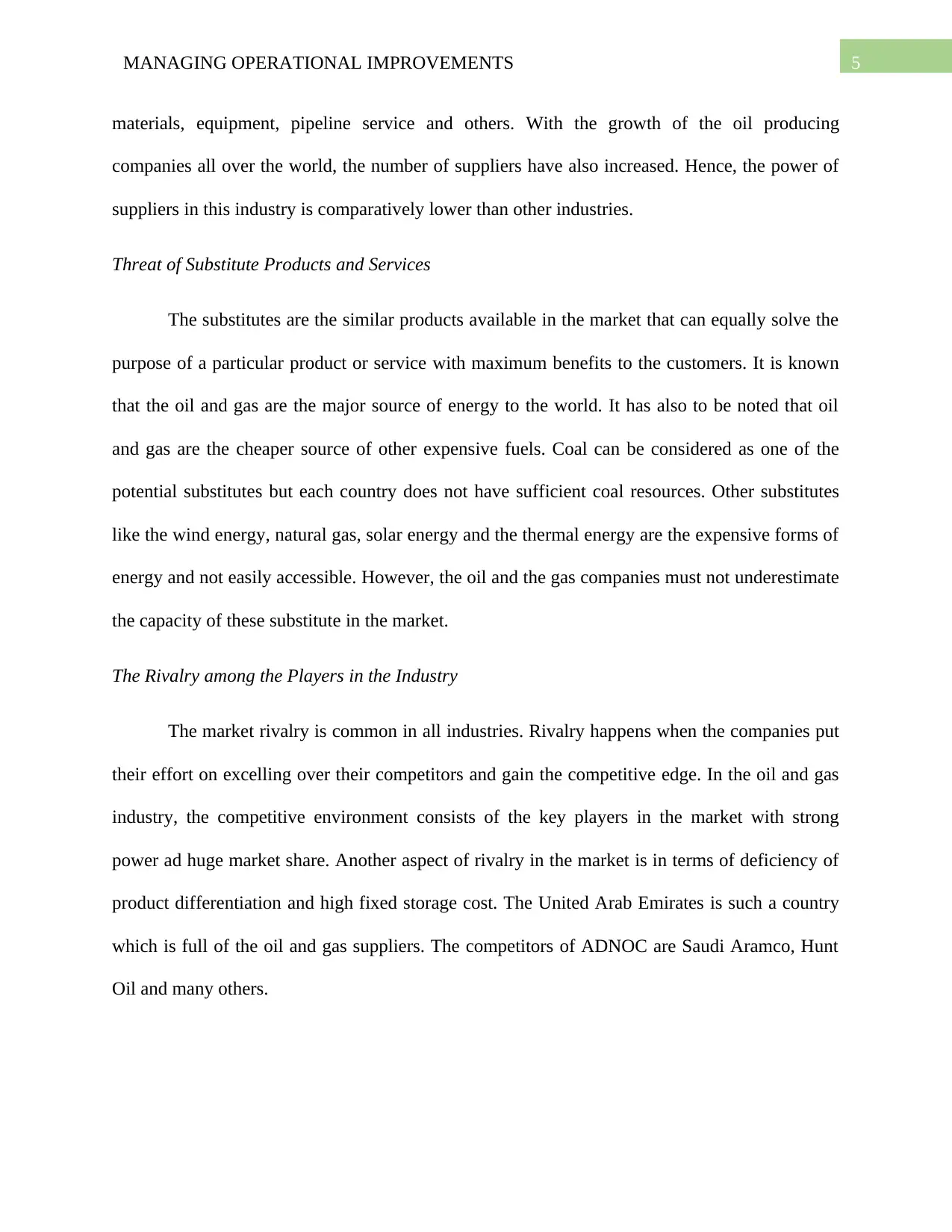
5MANAGING OPERATIONAL IMPROVEMENTS
materials, equipment, pipeline service and others. With the growth of the oil producing
companies all over the world, the number of suppliers have also increased. Hence, the power of
suppliers in this industry is comparatively lower than other industries.
Threat of Substitute Products and Services
The substitutes are the similar products available in the market that can equally solve the
purpose of a particular product or service with maximum benefits to the customers. It is known
that the oil and gas are the major source of energy to the world. It has also to be noted that oil
and gas are the cheaper source of other expensive fuels. Coal can be considered as one of the
potential substitutes but each country does not have sufficient coal resources. Other substitutes
like the wind energy, natural gas, solar energy and the thermal energy are the expensive forms of
energy and not easily accessible. However, the oil and the gas companies must not underestimate
the capacity of these substitute in the market.
The Rivalry among the Players in the Industry
The market rivalry is common in all industries. Rivalry happens when the companies put
their effort on excelling over their competitors and gain the competitive edge. In the oil and gas
industry, the competitive environment consists of the key players in the market with strong
power ad huge market share. Another aspect of rivalry in the market is in terms of deficiency of
product differentiation and high fixed storage cost. The United Arab Emirates is such a country
which is full of the oil and gas suppliers. The competitors of ADNOC are Saudi Aramco, Hunt
Oil and many others.
materials, equipment, pipeline service and others. With the growth of the oil producing
companies all over the world, the number of suppliers have also increased. Hence, the power of
suppliers in this industry is comparatively lower than other industries.
Threat of Substitute Products and Services
The substitutes are the similar products available in the market that can equally solve the
purpose of a particular product or service with maximum benefits to the customers. It is known
that the oil and gas are the major source of energy to the world. It has also to be noted that oil
and gas are the cheaper source of other expensive fuels. Coal can be considered as one of the
potential substitutes but each country does not have sufficient coal resources. Other substitutes
like the wind energy, natural gas, solar energy and the thermal energy are the expensive forms of
energy and not easily accessible. However, the oil and the gas companies must not underestimate
the capacity of these substitute in the market.
The Rivalry among the Players in the Industry
The market rivalry is common in all industries. Rivalry happens when the companies put
their effort on excelling over their competitors and gain the competitive edge. In the oil and gas
industry, the competitive environment consists of the key players in the market with strong
power ad huge market share. Another aspect of rivalry in the market is in terms of deficiency of
product differentiation and high fixed storage cost. The United Arab Emirates is such a country
which is full of the oil and gas suppliers. The competitors of ADNOC are Saudi Aramco, Hunt
Oil and many others.
⊘ This is a preview!⊘
Do you want full access?
Subscribe today to unlock all pages.

Trusted by 1+ million students worldwide
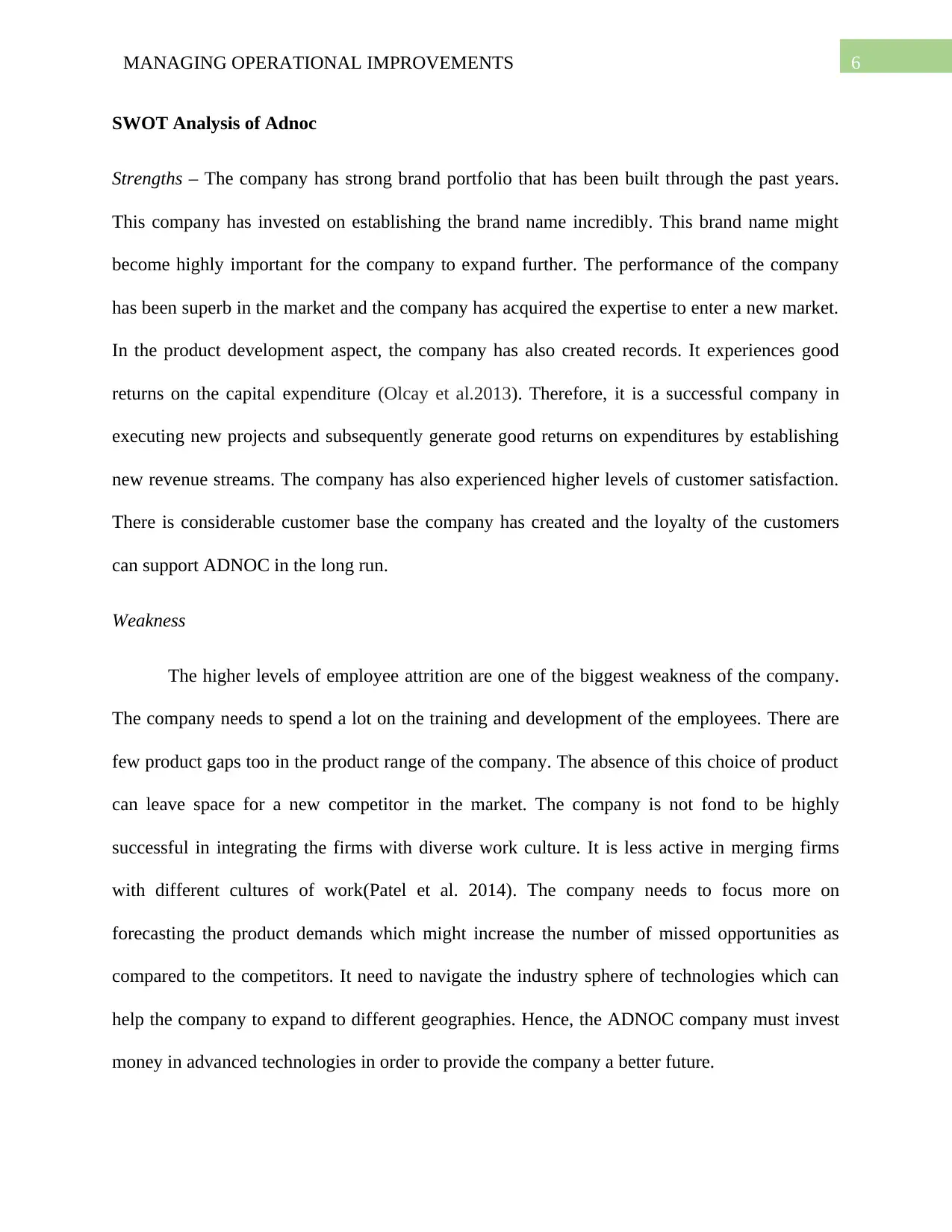
6MANAGING OPERATIONAL IMPROVEMENTS
SWOT Analysis of Adnoc
Strengths – The company has strong brand portfolio that has been built through the past years.
This company has invested on establishing the brand name incredibly. This brand name might
become highly important for the company to expand further. The performance of the company
has been superb in the market and the company has acquired the expertise to enter a new market.
In the product development aspect, the company has also created records. It experiences good
returns on the capital expenditure (Olcay et al.2013). Therefore, it is a successful company in
executing new projects and subsequently generate good returns on expenditures by establishing
new revenue streams. The company has also experienced higher levels of customer satisfaction.
There is considerable customer base the company has created and the loyalty of the customers
can support ADNOC in the long run.
Weakness
The higher levels of employee attrition are one of the biggest weakness of the company.
The company needs to spend a lot on the training and development of the employees. There are
few product gaps too in the product range of the company. The absence of this choice of product
can leave space for a new competitor in the market. The company is not fond to be highly
successful in integrating the firms with diverse work culture. It is less active in merging firms
with different cultures of work(Patel et al. 2014). The company needs to focus more on
forecasting the product demands which might increase the number of missed opportunities as
compared to the competitors. It need to navigate the industry sphere of technologies which can
help the company to expand to different geographies. Hence, the ADNOC company must invest
money in advanced technologies in order to provide the company a better future.
SWOT Analysis of Adnoc
Strengths – The company has strong brand portfolio that has been built through the past years.
This company has invested on establishing the brand name incredibly. This brand name might
become highly important for the company to expand further. The performance of the company
has been superb in the market and the company has acquired the expertise to enter a new market.
In the product development aspect, the company has also created records. It experiences good
returns on the capital expenditure (Olcay et al.2013). Therefore, it is a successful company in
executing new projects and subsequently generate good returns on expenditures by establishing
new revenue streams. The company has also experienced higher levels of customer satisfaction.
There is considerable customer base the company has created and the loyalty of the customers
can support ADNOC in the long run.
Weakness
The higher levels of employee attrition are one of the biggest weakness of the company.
The company needs to spend a lot on the training and development of the employees. There are
few product gaps too in the product range of the company. The absence of this choice of product
can leave space for a new competitor in the market. The company is not fond to be highly
successful in integrating the firms with diverse work culture. It is less active in merging firms
with different cultures of work(Patel et al. 2014). The company needs to focus more on
forecasting the product demands which might increase the number of missed opportunities as
compared to the competitors. It need to navigate the industry sphere of technologies which can
help the company to expand to different geographies. Hence, the ADNOC company must invest
money in advanced technologies in order to provide the company a better future.
Paraphrase This Document
Need a fresh take? Get an instant paraphrase of this document with our AI Paraphraser
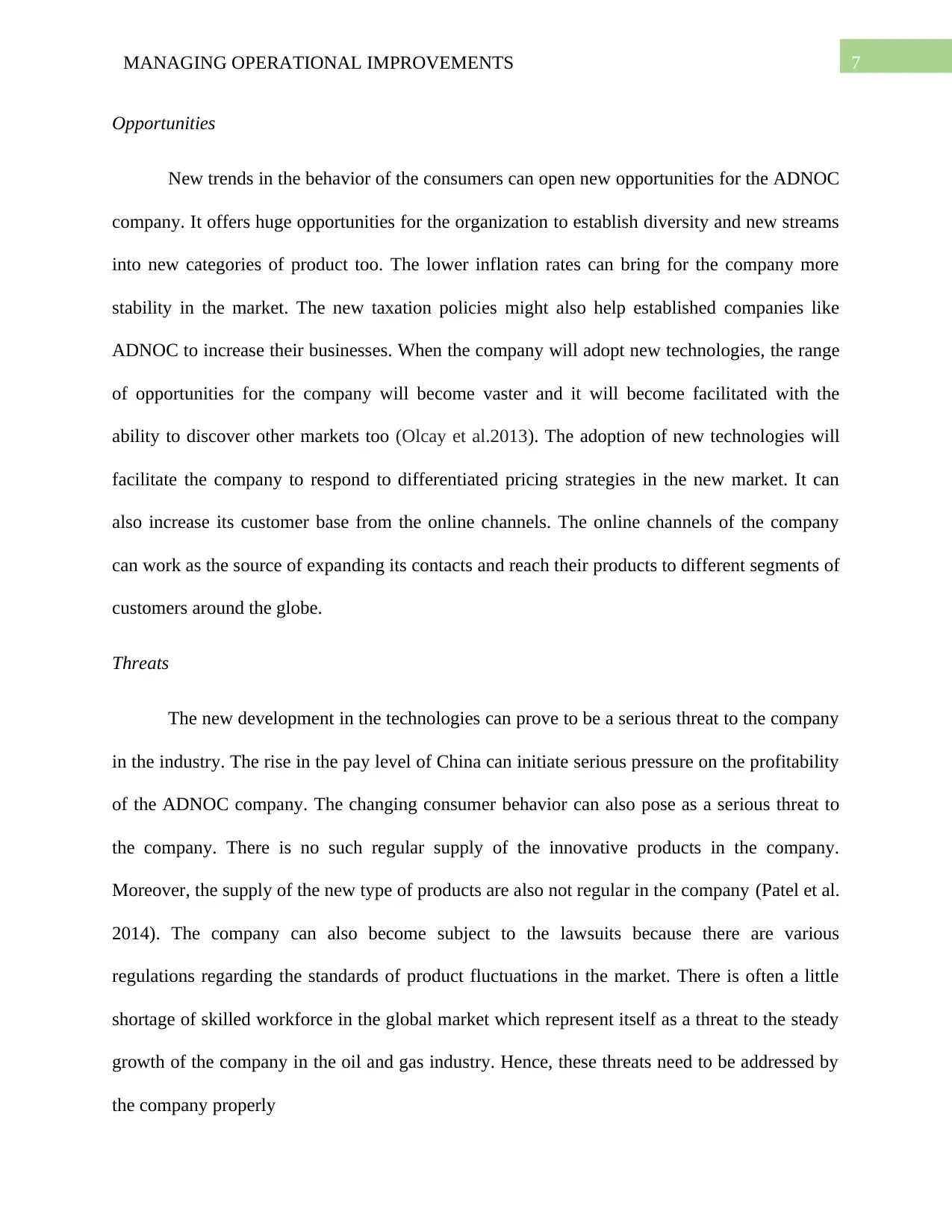
7MANAGING OPERATIONAL IMPROVEMENTS
Opportunities
New trends in the behavior of the consumers can open new opportunities for the ADNOC
company. It offers huge opportunities for the organization to establish diversity and new streams
into new categories of product too. The lower inflation rates can bring for the company more
stability in the market. The new taxation policies might also help established companies like
ADNOC to increase their businesses. When the company will adopt new technologies, the range
of opportunities for the company will become vaster and it will become facilitated with the
ability to discover other markets too (Olcay et al.2013). The adoption of new technologies will
facilitate the company to respond to differentiated pricing strategies in the new market. It can
also increase its customer base from the online channels. The online channels of the company
can work as the source of expanding its contacts and reach their products to different segments of
customers around the globe.
Threats
The new development in the technologies can prove to be a serious threat to the company
in the industry. The rise in the pay level of China can initiate serious pressure on the profitability
of the ADNOC company. The changing consumer behavior can also pose as a serious threat to
the company. There is no such regular supply of the innovative products in the company.
Moreover, the supply of the new type of products are also not regular in the company (Patel et al.
2014). The company can also become subject to the lawsuits because there are various
regulations regarding the standards of product fluctuations in the market. There is often a little
shortage of skilled workforce in the global market which represent itself as a threat to the steady
growth of the company in the oil and gas industry. Hence, these threats need to be addressed by
the company properly
Opportunities
New trends in the behavior of the consumers can open new opportunities for the ADNOC
company. It offers huge opportunities for the organization to establish diversity and new streams
into new categories of product too. The lower inflation rates can bring for the company more
stability in the market. The new taxation policies might also help established companies like
ADNOC to increase their businesses. When the company will adopt new technologies, the range
of opportunities for the company will become vaster and it will become facilitated with the
ability to discover other markets too (Olcay et al.2013). The adoption of new technologies will
facilitate the company to respond to differentiated pricing strategies in the new market. It can
also increase its customer base from the online channels. The online channels of the company
can work as the source of expanding its contacts and reach their products to different segments of
customers around the globe.
Threats
The new development in the technologies can prove to be a serious threat to the company
in the industry. The rise in the pay level of China can initiate serious pressure on the profitability
of the ADNOC company. The changing consumer behavior can also pose as a serious threat to
the company. There is no such regular supply of the innovative products in the company.
Moreover, the supply of the new type of products are also not regular in the company (Patel et al.
2014). The company can also become subject to the lawsuits because there are various
regulations regarding the standards of product fluctuations in the market. There is often a little
shortage of skilled workforce in the global market which represent itself as a threat to the steady
growth of the company in the oil and gas industry. Hence, these threats need to be addressed by
the company properly
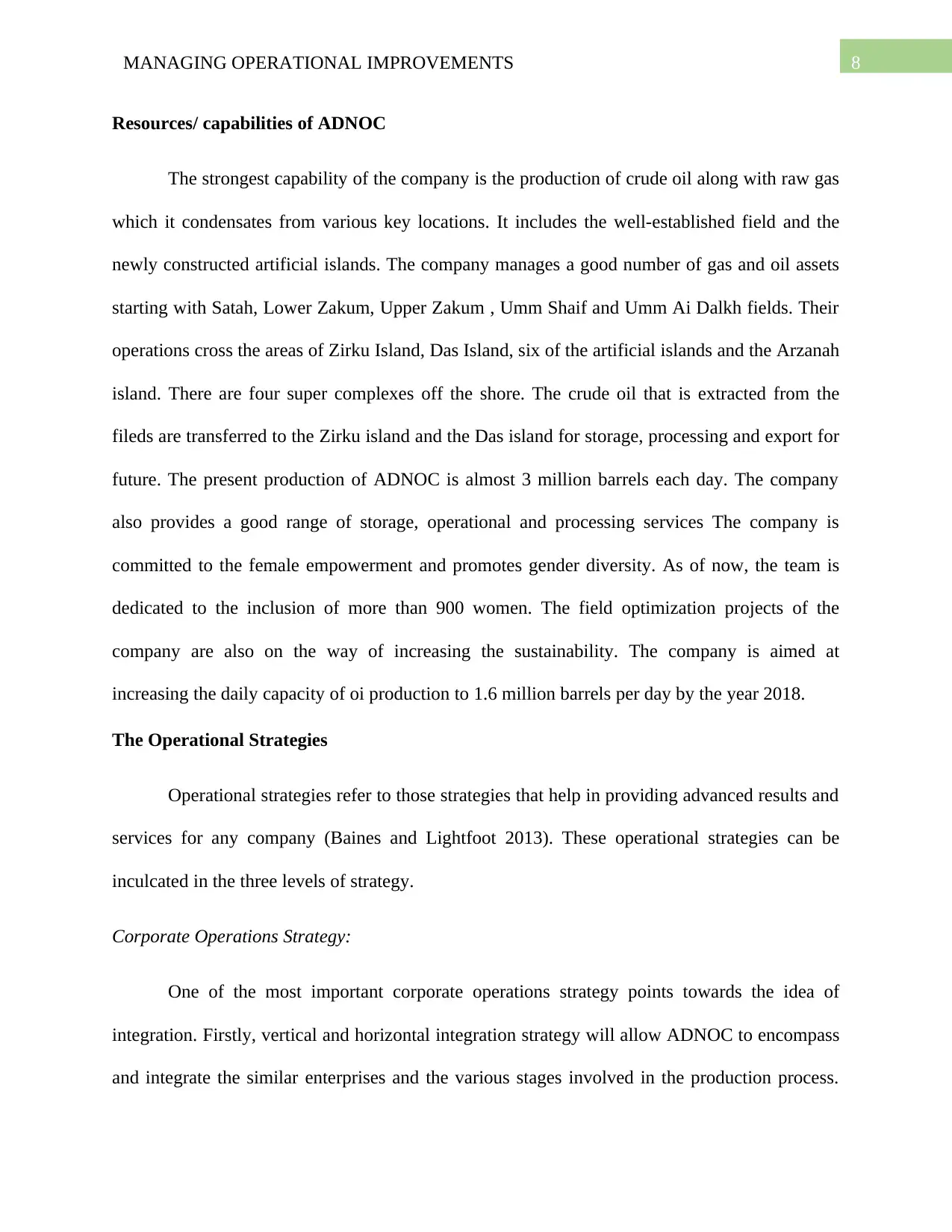
8MANAGING OPERATIONAL IMPROVEMENTS
Resources/ capabilities of ADNOC
The strongest capability of the company is the production of crude oil along with raw gas
which it condensates from various key locations. It includes the well-established field and the
newly constructed artificial islands. The company manages a good number of gas and oil assets
starting with Satah, Lower Zakum, Upper Zakum , Umm Shaif and Umm Ai Dalkh fields. Their
operations cross the areas of Zirku Island, Das Island, six of the artificial islands and the Arzanah
island. There are four super complexes off the shore. The crude oil that is extracted from the
fileds are transferred to the Zirku island and the Das island for storage, processing and export for
future. The present production of ADNOC is almost 3 million barrels each day. The company
also provides a good range of storage, operational and processing services The company is
committed to the female empowerment and promotes gender diversity. As of now, the team is
dedicated to the inclusion of more than 900 women. The field optimization projects of the
company are also on the way of increasing the sustainability. The company is aimed at
increasing the daily capacity of oi production to 1.6 million barrels per day by the year 2018.
The Operational Strategies
Operational strategies refer to those strategies that help in providing advanced results and
services for any company (Baines and Lightfoot 2013). These operational strategies can be
inculcated in the three levels of strategy.
Corporate Operations Strategy:
One of the most important corporate operations strategy points towards the idea of
integration. Firstly, vertical and horizontal integration strategy will allow ADNOC to encompass
and integrate the similar enterprises and the various stages involved in the production process.
Resources/ capabilities of ADNOC
The strongest capability of the company is the production of crude oil along with raw gas
which it condensates from various key locations. It includes the well-established field and the
newly constructed artificial islands. The company manages a good number of gas and oil assets
starting with Satah, Lower Zakum, Upper Zakum , Umm Shaif and Umm Ai Dalkh fields. Their
operations cross the areas of Zirku Island, Das Island, six of the artificial islands and the Arzanah
island. There are four super complexes off the shore. The crude oil that is extracted from the
fileds are transferred to the Zirku island and the Das island for storage, processing and export for
future. The present production of ADNOC is almost 3 million barrels each day. The company
also provides a good range of storage, operational and processing services The company is
committed to the female empowerment and promotes gender diversity. As of now, the team is
dedicated to the inclusion of more than 900 women. The field optimization projects of the
company are also on the way of increasing the sustainability. The company is aimed at
increasing the daily capacity of oi production to 1.6 million barrels per day by the year 2018.
The Operational Strategies
Operational strategies refer to those strategies that help in providing advanced results and
services for any company (Baines and Lightfoot 2013). These operational strategies can be
inculcated in the three levels of strategy.
Corporate Operations Strategy:
One of the most important corporate operations strategy points towards the idea of
integration. Firstly, vertical and horizontal integration strategy will allow ADNOC to encompass
and integrate the similar enterprises and the various stages involved in the production process.
⊘ This is a preview!⊘
Do you want full access?
Subscribe today to unlock all pages.

Trusted by 1+ million students worldwide
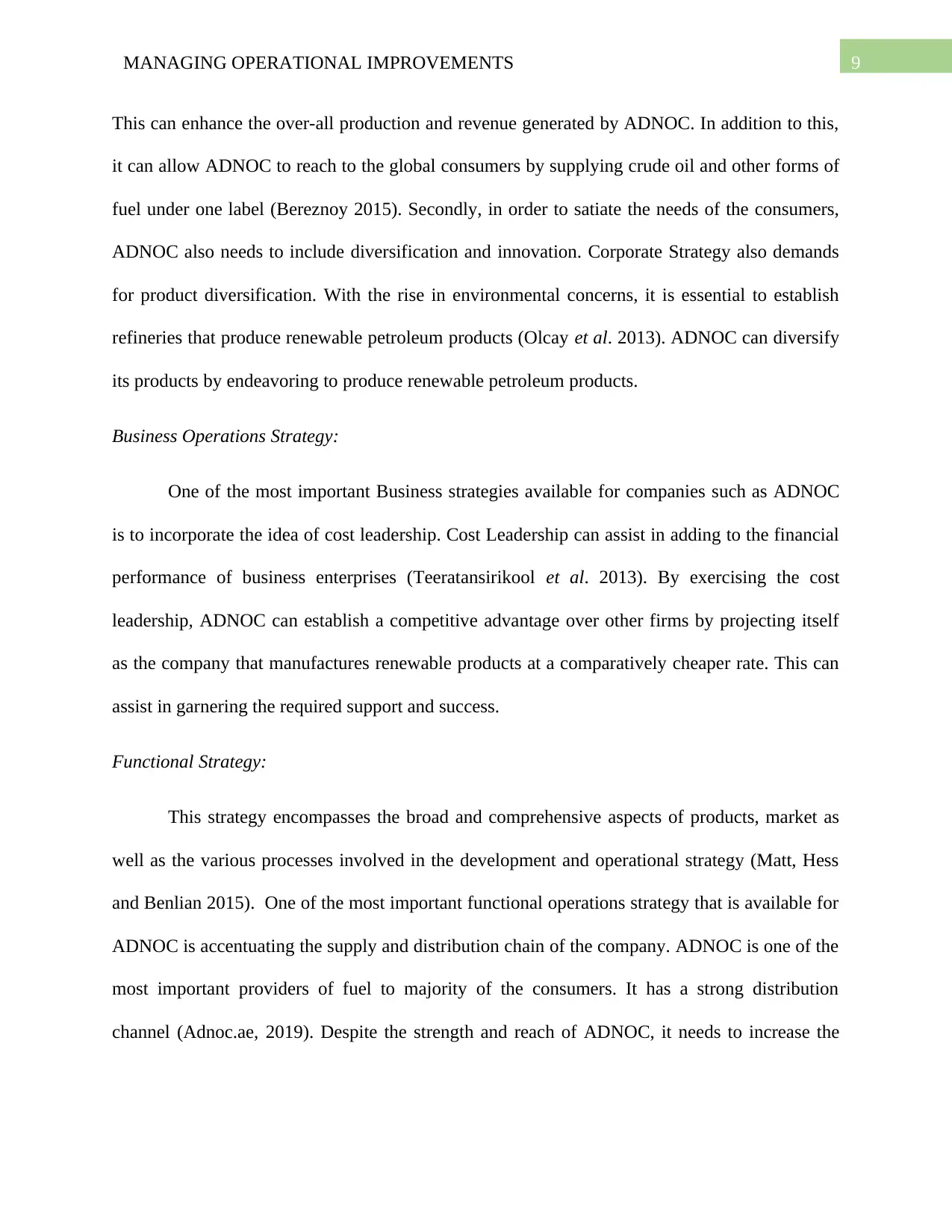
9MANAGING OPERATIONAL IMPROVEMENTS
This can enhance the over-all production and revenue generated by ADNOC. In addition to this,
it can allow ADNOC to reach to the global consumers by supplying crude oil and other forms of
fuel under one label (Bereznoy 2015). Secondly, in order to satiate the needs of the consumers,
ADNOC also needs to include diversification and innovation. Corporate Strategy also demands
for product diversification. With the rise in environmental concerns, it is essential to establish
refineries that produce renewable petroleum products (Olcay et al. 2013). ADNOC can diversify
its products by endeavoring to produce renewable petroleum products.
Business Operations Strategy:
One of the most important Business strategies available for companies such as ADNOC
is to incorporate the idea of cost leadership. Cost Leadership can assist in adding to the financial
performance of business enterprises (Teeratansirikool et al. 2013). By exercising the cost
leadership, ADNOC can establish a competitive advantage over other firms by projecting itself
as the company that manufactures renewable products at a comparatively cheaper rate. This can
assist in garnering the required support and success.
Functional Strategy:
This strategy encompasses the broad and comprehensive aspects of products, market as
well as the various processes involved in the development and operational strategy (Matt, Hess
and Benlian 2015). One of the most important functional operations strategy that is available for
ADNOC is accentuating the supply and distribution chain of the company. ADNOC is one of the
most important providers of fuel to majority of the consumers. It has a strong distribution
channel (Adnoc.ae, 2019). Despite the strength and reach of ADNOC, it needs to increase the
This can enhance the over-all production and revenue generated by ADNOC. In addition to this,
it can allow ADNOC to reach to the global consumers by supplying crude oil and other forms of
fuel under one label (Bereznoy 2015). Secondly, in order to satiate the needs of the consumers,
ADNOC also needs to include diversification and innovation. Corporate Strategy also demands
for product diversification. With the rise in environmental concerns, it is essential to establish
refineries that produce renewable petroleum products (Olcay et al. 2013). ADNOC can diversify
its products by endeavoring to produce renewable petroleum products.
Business Operations Strategy:
One of the most important Business strategies available for companies such as ADNOC
is to incorporate the idea of cost leadership. Cost Leadership can assist in adding to the financial
performance of business enterprises (Teeratansirikool et al. 2013). By exercising the cost
leadership, ADNOC can establish a competitive advantage over other firms by projecting itself
as the company that manufactures renewable products at a comparatively cheaper rate. This can
assist in garnering the required support and success.
Functional Strategy:
This strategy encompasses the broad and comprehensive aspects of products, market as
well as the various processes involved in the development and operational strategy (Matt, Hess
and Benlian 2015). One of the most important functional operations strategy that is available for
ADNOC is accentuating the supply and distribution chain of the company. ADNOC is one of the
most important providers of fuel to majority of the consumers. It has a strong distribution
channel (Adnoc.ae, 2019). Despite the strength and reach of ADNOC, it needs to increase the
Paraphrase This Document
Need a fresh take? Get an instant paraphrase of this document with our AI Paraphraser
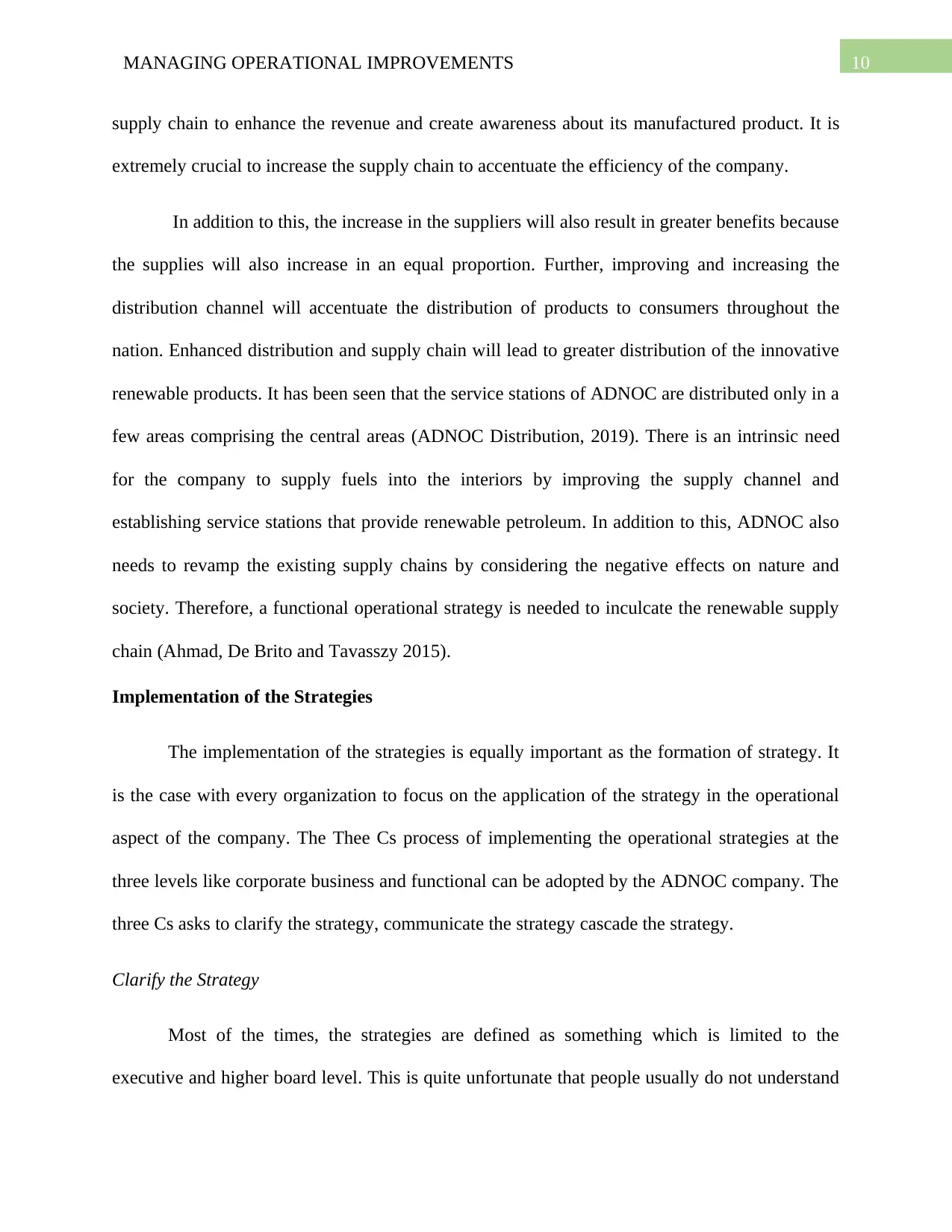
10MANAGING OPERATIONAL IMPROVEMENTS
supply chain to enhance the revenue and create awareness about its manufactured product. It is
extremely crucial to increase the supply chain to accentuate the efficiency of the company.
In addition to this, the increase in the suppliers will also result in greater benefits because
the supplies will also increase in an equal proportion. Further, improving and increasing the
distribution channel will accentuate the distribution of products to consumers throughout the
nation. Enhanced distribution and supply chain will lead to greater distribution of the innovative
renewable products. It has been seen that the service stations of ADNOC are distributed only in a
few areas comprising the central areas (ADNOC Distribution, 2019). There is an intrinsic need
for the company to supply fuels into the interiors by improving the supply channel and
establishing service stations that provide renewable petroleum. In addition to this, ADNOC also
needs to revamp the existing supply chains by considering the negative effects on nature and
society. Therefore, a functional operational strategy is needed to inculcate the renewable supply
chain (Ahmad, De Brito and Tavasszy 2015).
Implementation of the Strategies
The implementation of the strategies is equally important as the formation of strategy. It
is the case with every organization to focus on the application of the strategy in the operational
aspect of the company. The Thee Cs process of implementing the operational strategies at the
three levels like corporate business and functional can be adopted by the ADNOC company. The
three Cs asks to clarify the strategy, communicate the strategy cascade the strategy.
Clarify the Strategy
Most of the times, the strategies are defined as something which is limited to the
executive and higher board level. This is quite unfortunate that people usually do not understand
supply chain to enhance the revenue and create awareness about its manufactured product. It is
extremely crucial to increase the supply chain to accentuate the efficiency of the company.
In addition to this, the increase in the suppliers will also result in greater benefits because
the supplies will also increase in an equal proportion. Further, improving and increasing the
distribution channel will accentuate the distribution of products to consumers throughout the
nation. Enhanced distribution and supply chain will lead to greater distribution of the innovative
renewable products. It has been seen that the service stations of ADNOC are distributed only in a
few areas comprising the central areas (ADNOC Distribution, 2019). There is an intrinsic need
for the company to supply fuels into the interiors by improving the supply channel and
establishing service stations that provide renewable petroleum. In addition to this, ADNOC also
needs to revamp the existing supply chains by considering the negative effects on nature and
society. Therefore, a functional operational strategy is needed to inculcate the renewable supply
chain (Ahmad, De Brito and Tavasszy 2015).
Implementation of the Strategies
The implementation of the strategies is equally important as the formation of strategy. It
is the case with every organization to focus on the application of the strategy in the operational
aspect of the company. The Thee Cs process of implementing the operational strategies at the
three levels like corporate business and functional can be adopted by the ADNOC company. The
three Cs asks to clarify the strategy, communicate the strategy cascade the strategy.
Clarify the Strategy
Most of the times, the strategies are defined as something which is limited to the
executive and higher board level. This is quite unfortunate that people usually do not understand
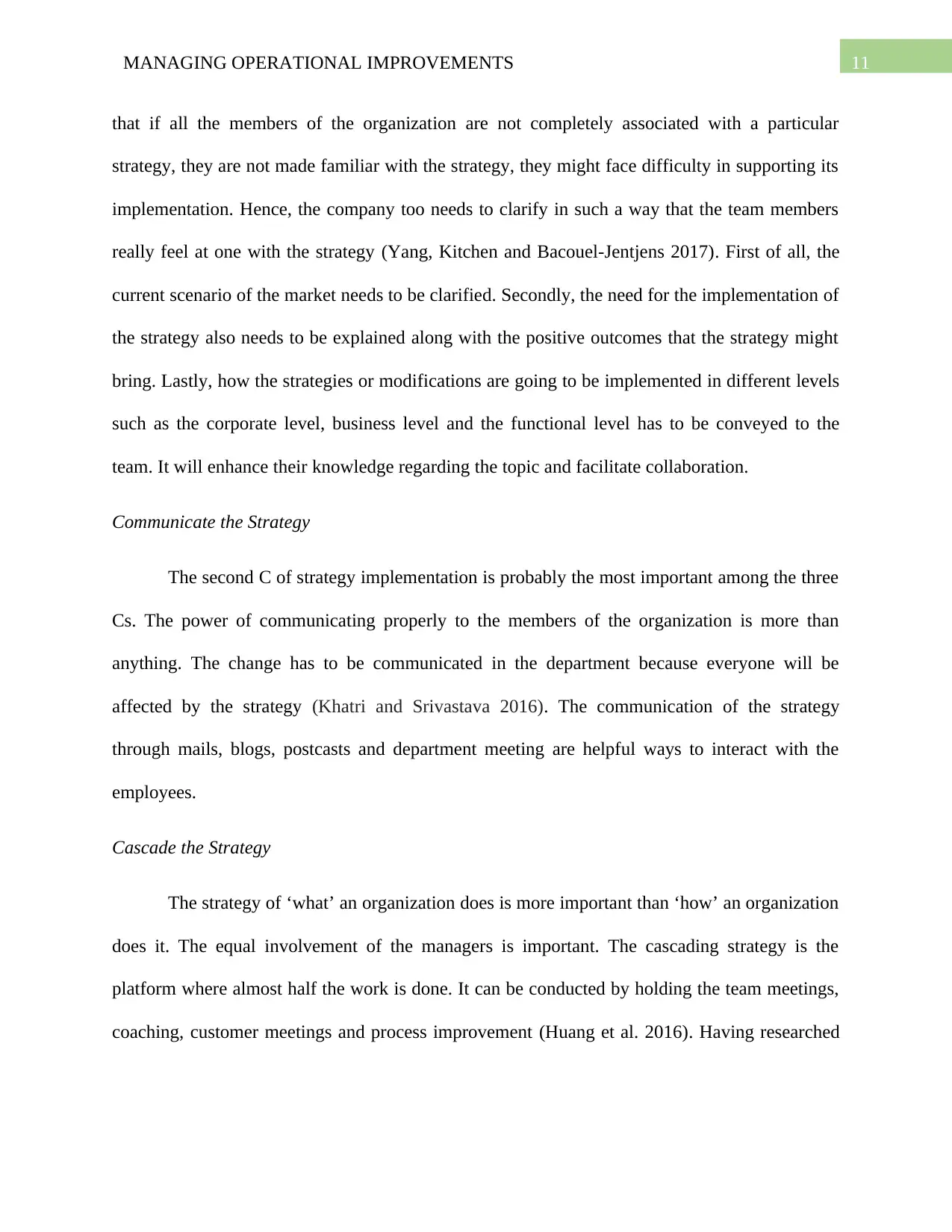
11MANAGING OPERATIONAL IMPROVEMENTS
that if all the members of the organization are not completely associated with a particular
strategy, they are not made familiar with the strategy, they might face difficulty in supporting its
implementation. Hence, the company too needs to clarify in such a way that the team members
really feel at one with the strategy (Yang, Kitchen and Bacouel-Jentjens 2017). First of all, the
current scenario of the market needs to be clarified. Secondly, the need for the implementation of
the strategy also needs to be explained along with the positive outcomes that the strategy might
bring. Lastly, how the strategies or modifications are going to be implemented in different levels
such as the corporate level, business level and the functional level has to be conveyed to the
team. It will enhance their knowledge regarding the topic and facilitate collaboration.
Communicate the Strategy
The second C of strategy implementation is probably the most important among the three
Cs. The power of communicating properly to the members of the organization is more than
anything. The change has to be communicated in the department because everyone will be
affected by the strategy (Khatri and Srivastava 2016). The communication of the strategy
through mails, blogs, postcasts and department meeting are helpful ways to interact with the
employees.
Cascade the Strategy
The strategy of ‘what’ an organization does is more important than ‘how’ an organization
does it. The equal involvement of the managers is important. The cascading strategy is the
platform where almost half the work is done. It can be conducted by holding the team meetings,
coaching, customer meetings and process improvement (Huang et al. 2016). Having researched
that if all the members of the organization are not completely associated with a particular
strategy, they are not made familiar with the strategy, they might face difficulty in supporting its
implementation. Hence, the company too needs to clarify in such a way that the team members
really feel at one with the strategy (Yang, Kitchen and Bacouel-Jentjens 2017). First of all, the
current scenario of the market needs to be clarified. Secondly, the need for the implementation of
the strategy also needs to be explained along with the positive outcomes that the strategy might
bring. Lastly, how the strategies or modifications are going to be implemented in different levels
such as the corporate level, business level and the functional level has to be conveyed to the
team. It will enhance their knowledge regarding the topic and facilitate collaboration.
Communicate the Strategy
The second C of strategy implementation is probably the most important among the three
Cs. The power of communicating properly to the members of the organization is more than
anything. The change has to be communicated in the department because everyone will be
affected by the strategy (Khatri and Srivastava 2016). The communication of the strategy
through mails, blogs, postcasts and department meeting are helpful ways to interact with the
employees.
Cascade the Strategy
The strategy of ‘what’ an organization does is more important than ‘how’ an organization
does it. The equal involvement of the managers is important. The cascading strategy is the
platform where almost half the work is done. It can be conducted by holding the team meetings,
coaching, customer meetings and process improvement (Huang et al. 2016). Having researched
⊘ This is a preview!⊘
Do you want full access?
Subscribe today to unlock all pages.

Trusted by 1+ million students worldwide
1 out of 23
Related Documents
Your All-in-One AI-Powered Toolkit for Academic Success.
+13062052269
info@desklib.com
Available 24*7 on WhatsApp / Email
![[object Object]](/_next/static/media/star-bottom.7253800d.svg)
Unlock your academic potential
Copyright © 2020–2025 A2Z Services. All Rights Reserved. Developed and managed by ZUCOL.





